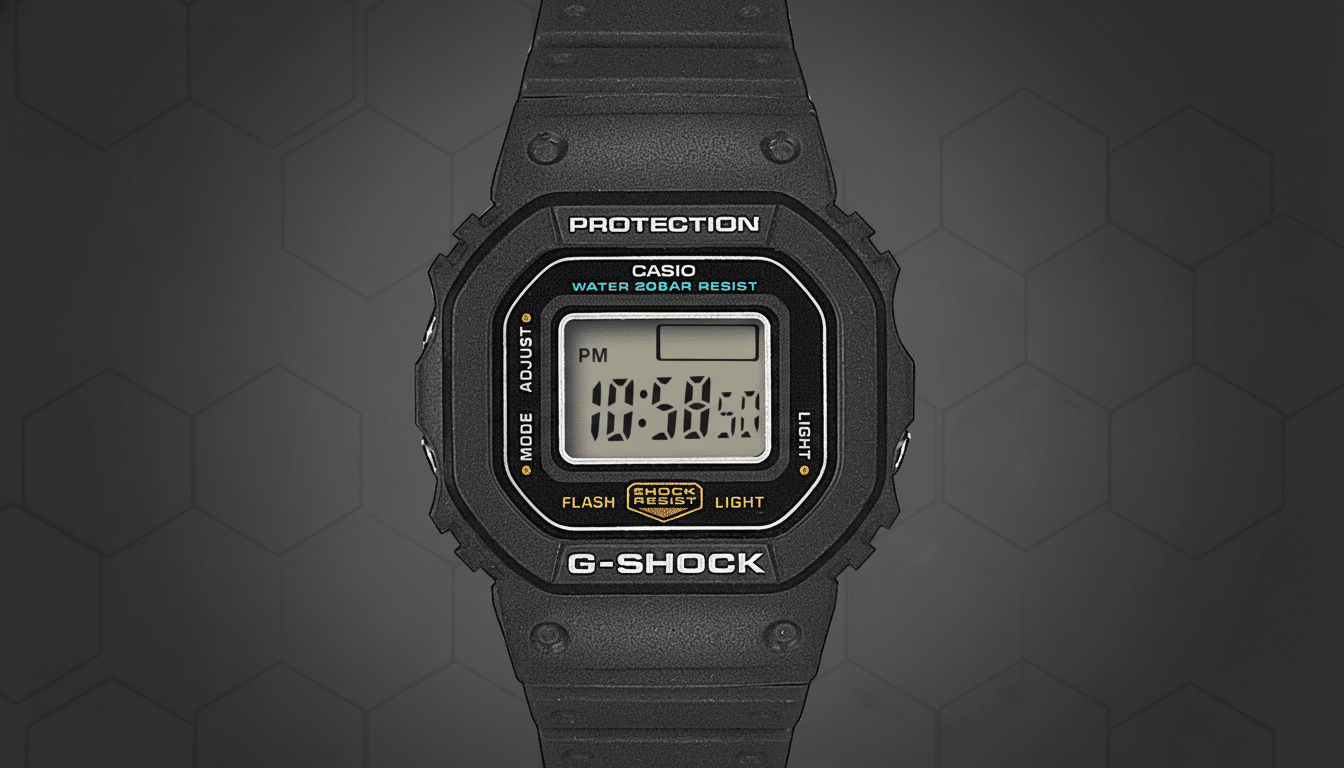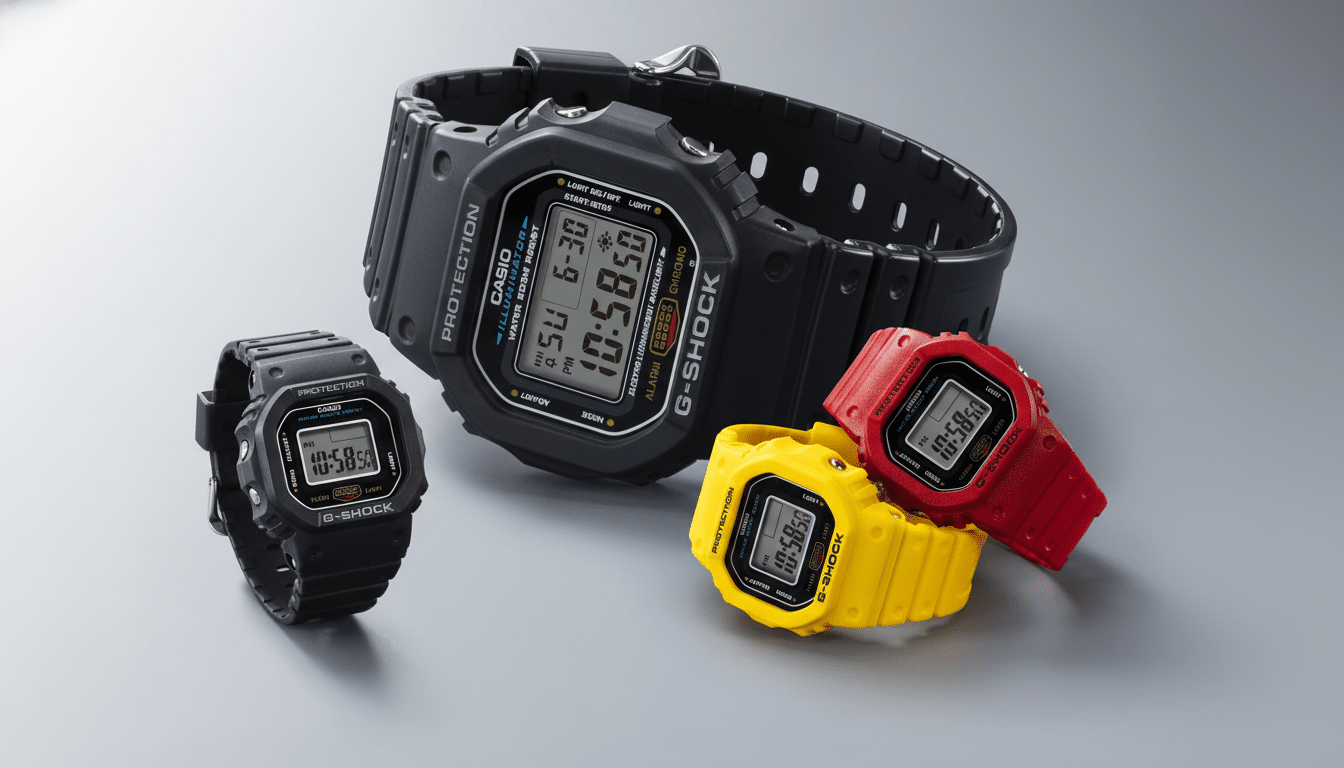Casio’s latest G-Shock Nano compresses the brand’s tough-as-nails watch DNA to finger size, making for a tiny, functional timepiece you literally wear as a ring.
It’s not a smart ring, and it doesn’t track your health, but it does what G-Shock does best: It tells time faithfully, stands up to abuse, and looks proudly retro — in a playful thumb-and-index-friendly form.

What The G-Shock Nano Is, And What It’s Not
The G-SHOCK NANO 5600 Series releases as a 1/10 scale digital timepiece inspired by the signature DW-5600, which has been part of the G-Shock lineup for over 30 years.
Consider it a smaller piece of wrist jewelry, not exactly a health wearable.
No heart rate sensor, no step counting, no notifications. What you don’t get are any of the other complications available on late-model G-Shocks such as an alarm, a countdown timer, world time, or one of Casio’s new mega-powerful sensors that detect altitude and atmospheric and water pressures all at once.
- No heart rate sensor
- No step counting
- No notifications
- No alarm
- No countdown timer
- No world time
- No newer multi-sensors for altitude, atmospheric, or water pressure
What you do get is an alphanumeric six-digit display for time (that would be hours, minutes, and seconds) with stopwatch, dual time (run two times concurrently), auto calendar (preset to 2039!), LED light (yay!), and selectable hourly flash alerts.
- Alphanumeric six-digit time display (hours, minutes, seconds)
- Stopwatch
- Dual time (run two times concurrently)
- Auto calendar (preset to 2039!)
- LED light (yay!)
- Selectable hourly flash alerts
Key here, those three side buttons are 100% working — mode switching, light activation, and adjustments all operate as they would on a standard G-Shock. The module is powered by a user-replaceable battery, so you are not tied to charging. This is a mechanics-minded twist on mini wearables, focusing on longevity and ease of use instead of apps and sensors.
Key Specs and Design Details of the G-Shock Nano
Casio claims the Nano is airtight and water-resistant to about 200 meters (the same 20-bar rating you’ll find on many full-size G-Shocks). That number is well beyond what the average ring experiences, but it speaks to the brand’s emphasis on durability. The case features stainless steel buttons and buckle, as well as a case back that embraces the 5600’s square shape in a humorous and accurate scaled-down form.

It is debuting in three colors — black, yellow, and red — and comes with a display stand and special packaging. It’s worth noting that the band is adjustable thanks to regular strap holes, so it will fit fingers from around 48 mm to 82 mm in circumference. That’s a solid upgrade from the original Version 1 finger-watch edition, which was offered in just one fixed size and thus never really made for skinny or large fingers.
And for being such a small watch, the legibility is better than you’d think in good lighting, and with help from the LED backlighting — not too dimly lit either. Treat it as a conversation starter and second, a backup timepiece — the engineering here is squeezing honest-to-goodness G-Shock performance into a ring-sized body without turning it into nothing more than a novelty prop.
How You Can Get Your Hands on a G-Shock Nano 5600
The G-Shock Nano 5600 will be released in Japan first through Casio’s official SKP channels and G-Shock retailers, with a tax-inclusive price of around $110. Casio is providing notifications for sales going live, and early batches are expected to sell out fast as the previous model did. If you’re outside of Japan, look to reputable importers or keep an eye out for domestic announcements — Casio is known to play distribution schedule games with some special releases.
Buying advice: figure out what color you might get now, sign up for availability alerts at the official product page, and prepare yourself for minimal early inventory. If it’s an import, consider additional shipping, duty, and warranty variables. Fit should be a little less precise than when buying the original, as the ring is now adjustable, but measure a finger you’re likely to use with it — index and thumb generally work best — and make sure this measurement falls between 48–82 mm.
Why the G-Shock Nano Matters for Today’s Wearables
Nano arrives as the age of smart rings ramps up, with major brands testing finger-wielding sensors. Casio’s riposte is a breath of fresh air: a pure-watch experience boiled down to its whimsy-ish essence. It draws on decades of G-Shock heritage — shock resistance and no-fuss reliability, with bold design — while avoiding the battery anxiety and app ecosystems that define today’s wearables. Casio’s financial reports estimate that G-Shock has now shipped well over 100 million units worldwide, and the Nano plays to that incredibly passionate fan base’s need for collectible, design-forward variants.
Early Fit and Everyday Use Tips for the G-Shock Nano
Think of the Nano as a weekend (or travel) accessory: a robust backup clock that’ll endure beaches, rain, or the gym, feeling hale and hearty. For everyday use, pick a finger that has space for the case so the device won’t squeeze into adjacent fingers when gripping tightly. Lift or use tools? Twist the watch head to the outside of the hand for comfort and to avoid accidental damage, as some do with full-size G-Shocks when worn on the wrist.
Bottom line: if you missed the initial go-round of finger-watch offerings, the resizable 5600-based Nano is the model to aim for. It retains the irreverent appeal, introduces wider sizing, and upholds that core G-Shock promise — durable, practical timekeeping — now in a ring built to take a hit and keep on ticking.

